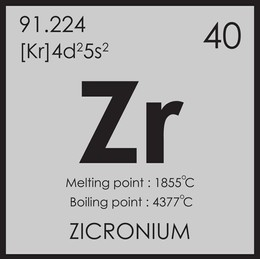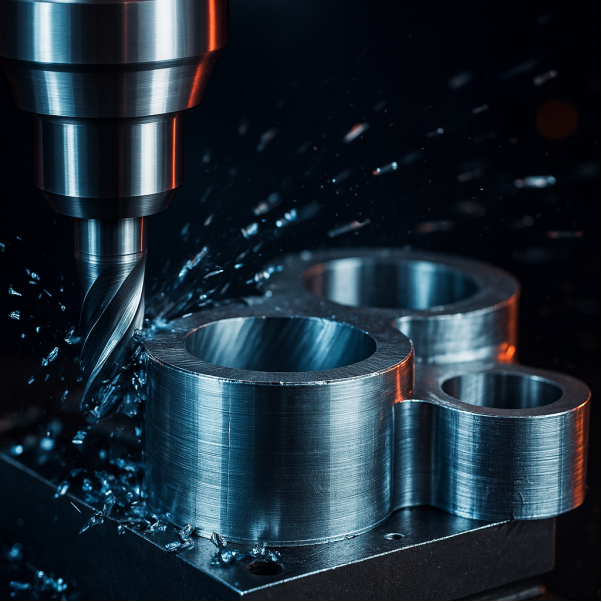Melting Point of Zinc: Temperature, Alloys, and Industrial Impact
 Jun 14,2025
Jun 14,2025

Zinc(Zn) is a versatile element and has many applications across different industries due to its unique properties. Zinc has relatively low melting point and sometimes, this makes its implications crucial. Understanding melting point of Zn is vital before its use in applications like galvanization. This article will give you insights into its key factors and its impact on different industrial applications.
What Is Zinc?
Zinc has a bluish-white, lustrous appearance. It is represented as symbol Zn and has 30 atomic number. It's a diamagnetic in nature is moderately reactive. It is known for its lower melting point and boiling point than other transition metals. Zinc also has moderate electrical conductivity and becomes malleable between 100-150°C.
Brief History of Zinc
Zn was used in brass production in ancient times. It was recognized as a distinct metal in 13th century in India. Later that, it was refined on large scale in China and then its use spread worldwide. In the 18th century it was re-discovered as a metal in Europe and the first zinc smelter was built in the 1740s.

Key Physical and Chemical Properties
Zn is brittle at room temperature and has Mohs hardness of 2.5. It reacts readily with air and a dull grey zinc oxide layer is created as a result. It is reactive to both acids and bases and form complex compounds. It has natural resistance to corrosion.
At What Temperature Does Zinc Melt?
Melting point of Zn is a crucial feature that affects most of its properties, especially the CNC Machining of zinc.
Exact Melting Point in °C and °F
Zinc has a melting point of 419.5 °C and 787.15 °F. and it has a boiling point of 907 °C.
Freezing Point and Solidification Range
Freezing point of zinc is actually the melting point of Zn. The standard value of freezing point of zinc is its solidification range and can vary depending on its purity. Impurities lower the freezing point, same a adding salt to water decreases its freezing point.
3 Factors That Shift Zinc's Melting Temperature
Here are 3 factors that affect the melting temperature of zinc metals:
1.Zinc Purity
Impurities lower the melting point of zinc, and the presence of traces can distort the crystal structure of zinc. This distortion requires less energy to break the bond and therefore, lowering its melting point.
2.Common Alloying Elements (Al, Mg, Cu)
Addition of alloying elements lowers the melting point of zinc. They alter the bonding and molecular structure of zinc. This affects the transition temperature of solid to liquid transition.
3.Atmospheric Pressure
Increase in ambient pressure increases the melting point. But a protective atmosphere affects the rate of evaporation and oxidation and eventually the melting point of Zn.
Why Is Zinc's Melting Point Relatively Low?
Zinc has lower melting point due to its weak metallic bonding. It has large atomic size, and its nature of crystal structure requires less energy to transit from solid to liquid.
Atomic Bonding and Crystal Structure
Zn has a distorted hexagonal close-packed (HCP) crystal structure. It has metallic bonding with the coordination number of 12, six at shorter and six at longer distances. The Zn-Zn bonds are a mixture of corner, edge, and face-sharing cuboctahedra.
Comparison With Neighboring Elements in the Periodic Table
Zinc shares the same appearance as cadmium and mercury, a silvery-white color. all have relatively low melting and boiling points. Zn is also like magnesium with +2 oxidation state and ionic size.
Zinc vs. Other Metals: Melting Point Chart
A brief comparison chart of melting points of different elements are as follows:
|
Metals |
Melting Point (°C) |
Melting Point (°F) |
|
Zn |
419.53 |
787.15 |
|
Aluminum |
660.32 |
1220.58 |
|
Gold |
1064.18 |
1947.52 |
|
Iron |
1538 |
2800.4 |
|
Silver |
961.93 |
1763.47 |
|
Titanium |
1668 |
3032.4 |
Zinc vs. Aluminum, Copper, Lead, and Tin
Copper has the highest melting point among all and then aluminum, zinc, lead and tin has the lowest melting point. In terms of its effect on machinability, copper is the most challenging one, while Al and Tin are easy to machine. More details along with their melting points are discussed below.
|
Metal |
Melting Point (°C) |
CNC Machineability |
|
Zn |
419.53 |
Good machinability but can be challenging due to its softness. It has higher machinability in alloy form |
|
A |
660.32 |
High machinability in alloy form. |
|
Cu |
1084.62 |
Machinable but requires specialized tools and techniques due to its high melting point. |
|
Pb |
327.5 |
Soft and easy machinability. |
|
Sn |
231.93 |
It is very soft and easy to machine. |
How Melting Range Influences Metal Selection
High melting points implies metal can withstand elevated temperature without being melted or degraded and maintain structural integrity. Examples are titanium, stainless steel, tungsten. Low melting point means metal can deform easily at lower temperatures and has efficient and cost-effective manufacturing. Examples are Aluminum, zinc and copper.
Melting Point Ranges of Popular Zinc Alloys
Common zinc alloys and their melting point are discussed below:
Zamak 3, 5, and 7
Zamak alloys have lower melting points and are mostly utilized in die casting.
ZA-8, ZA-12, and ZA-27
ZA-alloys also have lower melting points and thus are suitable for die casting.
EZAC and ACuZinc High-Performance Grades
These are high-performance grades and are used in demanding applications. These are also suitable for die casting and have the same melting point as ZA-alloys.
|
Alloy |
Melting Point Range (°C) |
Melting Point Range (°F) |
|
Zamak 3 |
381 - 387 |
718 - 729 |
|
Zamak 5 |
380 - 386 |
716 - 727 |
|
Zamak 7 |
381 - 387 |
718 - 729 |
|
ZA-8 |
375 - 404 |
707 - 759 |
|
ZA-12 |
875 - 1050 |
1607-1922 |
|
ZA-27 |
875 - 1050 |
1607-1922 |
|
ACuZinc |
375-404 |
707-759 |
|
EZAC |
375-404 |
707-759 |
Safe Melting and Casting Practices for Zinc
Safe zinc melting and casting needs careful attention to furnace working, temperature control, and fume control. Important information about these factors is discussed below.
How to Choose Crucible and Furnace?
Mild steel crucibles are used for zinc melting. For zinc casting, silicon carbide crucibles are used. Propane-powered furnaces or electric induction furnaces are used for melting zinc. For slow heating, sweating furnaces (rotary, reverberatory, or muffle) are used for scrap containing zinc.
How to Better Control Temperature and Flux Usage?
Insulated chambers and temperature control systems and insulated chambers are used to maintain heat levels. Thermal insulation also minimizes heat loss and maintains a heating rate. ECO - ZINC FLUX is normally used in zinc melting to remove impurities and improve its fluidity.
Fume Control and Personal Protective Equipment
Good ventilation minimizes fume exposure. Proper safety clothing like PPE must be used while working with melted zinc or other metals.
6 Common Industrial Uses of Zinc
Zn is a versatile metal and has many uses ranging from protective coatings to alloy components. Some of them are as:
1.Hot-Dip Galvanizing
Hot-dip galvanizing is dipping a workpiece like steel into molten zinc to create a protective coating. This provides protection against corrosion. Zinc when alloying with steel, creates a long-lasting and durable coating barrier.
2.Die Casting
Zinc alloys like Zamak alloys or ZA-alloys are mostly used in die casting. It is a high-pressure process that creates intricate, thin-walled components with high precision. This technique is suitable for mass production.
3.Low-Temperature Solder and Brazing Alloys
Zinc alloys are commonly utilized for low-temperature solders and brazing alloys. They create the metals joints at lower temperatures than traditional alloys.
4.Battery Manufacturing
Zn is an important element in Alkaline and zinc-carbon batteries.
5.Alloying
Zn alloying with other elements, most commonly with copper to create brass and bronze. These alloys are well-known for their versatile uses across many industries.
6.Chemical Industry
Zinc has good reactivity and is often used as reactant or catalyst in chemical reactions and processes.
Common Machining Methods for Zinc
Common CNC machining zinc includes processes like CNC Milling, CNC Turning, and CNC Drilling. These methods have computer-controlled machine tools for material removal and to create precise parts.

CNC Milling Zinc
Milling is a process in which a rotating cutting tool is utilized for material removal from zinc workpiece to create complex and intricate shapes and parts. CNC milling machines are used for this purpose and its typical use cases are custom or complex parts with tight tolerance. Tools used in CNC-milling zinc are solid carbide end mills and microtools.
CNC Turning Zinc
Turning is a process in which a rotating zinc workpiece is cut by stationary tools to form cylindrical shapes. CNC lathe machines are used for this purpose and typical use cases are shafts, knobs, and round housing. Various tools are used in CNC turning zinc such as insert tools, lathe tools.
CNC Drilling Zinc
Drilling is a process of creating holes in the zinc workpiece using rotating drills. CNC drill machines are used for these purposes and typical used cases are holes for screws, bolts, or specialized assembly. Tools used for CNC drilling zinc are solid carbide drills, and microtools.
CNC Grinding Zinc
Grinding is the process of removing small amounts of material from zinc workpieces to get precise surface finishes and tolerances. CNC grinders are used for these purposes and tools used for CNC grinding zinc are grinding wheels and abrasive tools.
CNC Machining Tips Near Zinc's Melting Threshold
When CNC machining closes to zinc's melting threshold, how could we do to make it better? Here are some tips for you. Also, if you are looking for a complete zinc alloy CNC machining solution, TUOFA Custom CNC Machining is your better choice. We will provide professional one-stop solutions to bring you a better project cooperation experience.
Chip Welding and Built-Up Edge Prevention
Heat causes chips welding at the cutting edge of the tool and reduces tool life and form poor surface finish. Built-up-edges are also common when material builds up on the cutting edges. These can be minimized by using high-pressure coolants, select optimized feed rate and speed to minimize heat buildup, use tools with positive rake angles and sharp cutting edges and chip breaking to prevent them from the tool adhering.
Coolant Choices
Coolants have different options like soluble coolants which are water-based coolants, and then synthetic coolants that provide good lubrication and cooling properties. but may require specialized handling and disposal procedures. Use high coolant concentration to prevent chip welding and built-up edge and make the coolant flow directly to the chip evacuation area.
Recommended Feeds & Speeds
Lower feed and high speed are recommended during CNC machining zinc to minimize heat buildup and chip welding. Use shallow depth of cut first and gradually increase it to make it comfortable with the machining parameters.
Tool Coatings
Tuofa offers advanced surface finish and tool coating services that are known for their high wear resistance and heat resistance. These are good choices for machining low melting points metals.
Conclusion
Zinc has a relatively low melting point of 419.5°C (787°F). This melting temperature makes it suitable for die casting create complex and thin-walled parts. Zinc alloys like brass also have lower melting temperatures which makes them use many applications for decorative purposes. But these applications normally vary depending on their composition, with some having melting points in the range of 380-390°C.
Zn is commonly used as in galvanizing for coating on steel for corrosion protection. Zn properties have an additional feature of ease of application and effectiveness in coating make it suitable for a preferred choice in many industries. Use coolant to prevent machining issues like chip welding and built-up edge.
FAQs About Zinc's Melting Point
Is zinc hard to melt?
No, it is definitely not hard to melt. Zinc has lower melting point than many other transition metals.
Why does molten zinc ignite certain metals?
It ignites certain metal because it forms a strong bond with them and causes a rapid reaction. This feature is used in galvanizing.
Can zinc be alloyed to raise its melting point?
Yes, it can be alloyed to raise its melting point. For example, brass, copper-zinc alloy, melts between 900-940°C.
What are the top 3 uses of low-melting zinc alloys?
Low-melting zinc alloys have many uses, but three common uses are die casting, soldering, and as phase change materials.
 Tel/WeChat:
Tel/WeChat:  Email:
Email: 
 Home
Home
 POM-H vs POM-C: Side-by-Side Guide for Engineers
POM-H vs POM-C: Side-by-Side Guide for Engineers 







